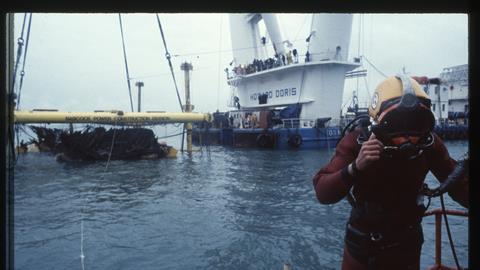‘The story has the potential to travel more widely and appeal to streamers’
Distributor Orange Smarty
Producer Stand Tall Media
Length 1 x 60 minutes
Broadcaster Channel 4 (UK)
The raising of King Henry VIII’s flagship Mary Rose in 1982 remains one of the most significant events in the history of maritime salvage. Comparable to the recovery of the 17th century Swedish warship Vasa in 1961, the climax of this complex and expensive operation was watched by around 60 million people worldwide.
“What many people don’t know, however, is that a lot of film footage of the operation was captured at the time – and then went missing,” says Orange Smarty founder and managing director Karen Young. “So some of the more specific details of the operation and the human interest side of the story have never been seen.”
Until now. “300 reels of footage were lost,” says Young. “But recently they were found in the archive of The Mary Rose Trust. They provide a fascinating insight into the operation and are the basis of the Mary Rose doc, which provides a completely revised account.”
“It all happened against the backdrop of the Falklands War and makes for very gripping viewing”
Young calls the single “a story of hidden tensions, jeopardy and new revelations”. One of the key narratives to emerge from the filming, for example, is the conflict between the archaeologists working on the project and the Royal Navy engineers called in to supervise the wreck dives.
“It all happened against the backdrop of the Falklands War and makes for very gripping viewing,” says Young. “One of the most intriguing aspects of the documentary is that it shows some of the original participants reviewing the lost footage – it’s very emotional.”
Parallel narratives
In effect, the documentary has two parallel narratives. First, it’s an opportunity to revisit the history of the Mary Rose on the 40th anniversary of its raising, with the added advantage of modern-day graphics and visual effects to tell the story.
Second, says Young: “It’s a chance to get under the skin of a dangerous and demanding salvage operation – thanks to the discovery of the footage. It was a very challenging job that took place in the face of poor weather conditions.”
Orange Smarty came on board the project early and has international rights excluding the UK and Ireland. For Young, the fact the original coverage of the story generated an audience of double-digit millions worldwide bodes well for sales – as does the huge number of tourists that visit the Mary Rose Museum each year.
“Also, the world has developed such a fascination with the Tudor period – much more so than in the 1980s,” she says. “Because of all the artefacts found on the wreck, the Mary Rose is regarded as a ‘Tudor time capsule’.
Our new monarch, King Charles III, has always been closely associated with the Mary Rose – he is president of the Trust and undertook several dives to the wreck. He was also directly involved on the day a crane was used to lift the ship from the seabed. So there’s a contemporaneous relevance.”
Young says likely buyers of the show are public broadcasters in English-speaking markets and Europe. “But the story has the potential to travel more widely and appeal to streamers. There are platforms in the US and Japan that would be interested in a documentary that uses unseen footage to bring history to life and change the narrative from what we thought we knew.”
Mipcom Hot Picks: Factual
- 1
- 2
- 3
- 4
- 5
- 6
- 7
 Currently reading
Currently readingHot Picks: Raising the Mary Rose: The Lost Tapes
- 8
- 9
- 10







































No comments yet